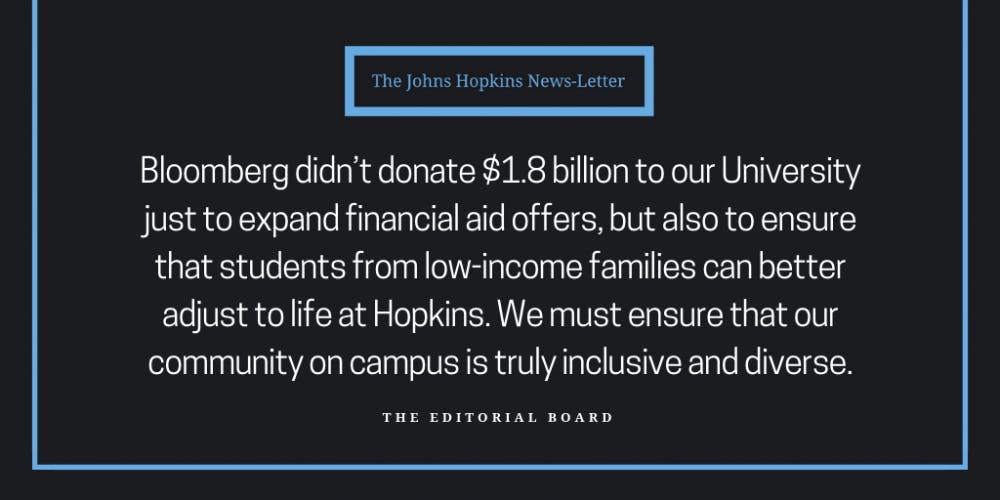Earlier this month, federal prosecutors charged dozens of wealthy parents for bribing or cheating their children’s ways into universities across the nation. Three days after the news of this college admissions scandal — now known as Operation Varsity Blues — broke, Hopkins welcomed 2,309 new applicants to its Class of 2023 at an acceptance rate of 7.7 percent, the lowest rate in the last few years.
While Hopkins has not been implicated in Operation Varsity Blues, the scandal reminds us that students from upper-class families have disproportionate advantages — both legal and illegal — when applying to college. As such, we think it’s worth taking a moment to consider what kinds of students get into Hopkins and what kinds of students are empowered to succeed here.
As an elite institution, Hopkins has not always been the most accessible school for lower-income students. Still, the University compares favorably to many of its peer institutions. The New York Times amassed data in 2017 showing that 38 American universities, including Washington University in St. Louis, Middlebury College and Tufts University, had more students from the top one percent income bracket than the bottom 60 percent. In contrast, 11.5 percent of Hopkins students come from the top one percent, whereas 14.5 percent come from the bottom 60.
At many elite institutions, applying as a legacy is a considerable advantage over other prospective students. At Harvard, legacy students make up 14 percent of the undergraduate student body. At the University of Southern California, a school implicated in the Varsity Blues scandal, 19 percent of the Class of 2022 are legacy students. At Hopkins, only 3.3 percent of those who came here in Fall 2018 were legacy students. According to our admissions website, legacy has “an extremely limited impact in the process and is only recognized in Early Decision.” We also do not conduct alumni interviews during the admissions process. Oftentimes the availability of such interviews is based on whether there are alumni in the applicant’s area, thus excluding those from more rural or less privileged communities.
As a need-blind institution, Hopkins also offers grants to 86 percent of families with incomes less than $200K. In the 2017-2018 academic year, Hopkins offered $100 million in grant aid to students. 15.4 percent of students here are also eligible for Pell Grants, which the U.S. Department of Education gives to students with demonstrated financial need. Michael Bloomberg’s recent $1.8 billion donation also means that Hopkins will be better able to aid students in need.
We do not yet have access to information on the socioeconomic and racial demographics of the incoming class, but we do know that regionally, Hopkins has attempted to admit a diverse pool of students. The Class of 2023 has students from 49 states, 91 countries and four U.S. territories.
Compared to many of its peer institutions, Hopkins has certainly done a better job in trying to open up opportunities for students from the lower income bracket. Still, the University should continue working to make itself more accessible to lower-income students.
It’s especially important for Hopkins to be community-facing in Baltimore. Take the University’s Baltimore Scholars Program, for example, which allows students graduating from public schools in Baltimore City to have their tuition fully or partially paid for in accordance with their family’s income. The program not only makes our institution more accessible, but is also a way to effectively address the perceived divide between Hopkins and Baltimore. However, as beneficial as this program may be for low-income students, the University could do a better job of promoting it within the community so that Baltimore students are more familiar with the program. In doing so Hopkins can open up more opportunities to Baltimore residents in addition to becoming more inclusive to all socioeconomic groups.
There are other barriers that prospective students face when applying to colleges. Some families struggle with FAFSA forms, which can be particularly convoluted for those for whom English is not their first language. As a result, their college-age students may be deterred from applying. In addition, low-income high schools often lack the resources commonly provided by wealthier schools to help students with these forms. Perhaps Hopkins can help alleviate this discrepancy by offering translation services and other assistance for families in need.
Bloomberg didn’t donate $1.8 billion to our University just to expand financial aid offers, but also to ensure that students from low-income families can better adjust to life at Hopkins. We must ensure that our community on campus is truly inclusive and diverse. We have a lot to be proud of, but that doesn’t mean we can’t do more to improve the application process and the accessibility of our University to deserving prospective students.
Editors’ note: One member of this week’s Editorial Board currently works in the University’s Office of Undergraduate Admissions.

















